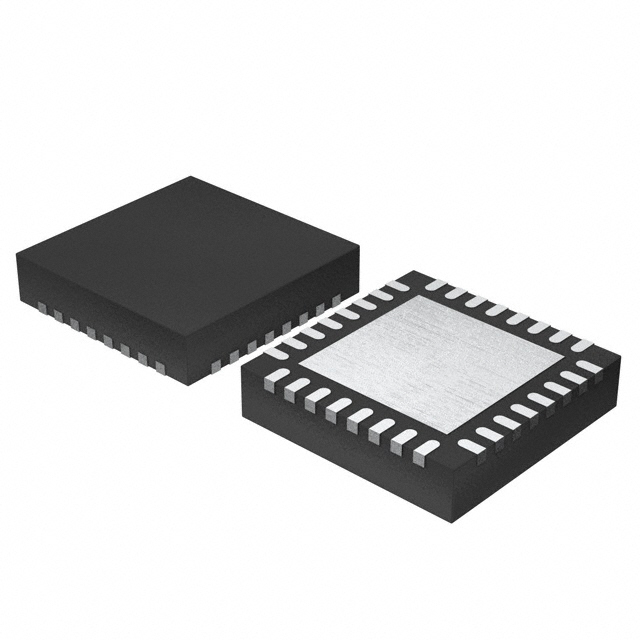LTC3858EUH#TRPBF
Product Overview
Category: Integrated Circuit (IC)
Use: Power Management
Characteristics: - High Efficiency - Wide Input Voltage Range - Adjustable Output Voltage - Synchronous Buck Converter
Package: 38-Lead QFN (Quad Flat No-Lead)
Essence: The LTC3858EUH#TRPBF is a high-performance synchronous buck converter IC used for power management applications. It offers high efficiency and a wide input voltage range, making it suitable for various electronic devices.
Packaging/Quantity: The LTC3858EUH#TRPBF is available in a 38-Lead QFN package. The quantity per package may vary depending on the supplier.
Specifications
- Input Voltage Range: 4.5V to 60V
- Output Voltage Range: 0.6V to 55V
- Maximum Output Current: 20A
- Switching Frequency: Up to 2MHz
- Efficiency: Up to 95%
- Operating Temperature Range: -40°C to 125°C
Detailed Pin Configuration
The LTC3858EUH#TRPBF has a total of 38 pins. Here is a brief overview of the pin functions:
- VIN: Input Voltage
- PGND: Power Ground
- SW1: Switch Node 1
- SW2: Switch Node 2
- VOUT: Output Voltage
- FB: Feedback Voltage
- COMP: Compensation Node
- SS: Soft-Start Control
- SYNC: Synchronization Input
- RUN/SS/TRK: Run/Soft-Start/Tracking Control
- EN/UVLO: Enable/Undervoltage Lockout Control
- RT/CLKOUT: Oscillator Resistor/Timing Capacitor
- CLKIN: Clock Input
- VCC: Supply Voltage
For a complete pin configuration diagram, please refer to the LTC3858EUH#TRPBF datasheet.
Functional Features
- High Efficiency Conversion
- Adjustable Output Voltage
- Synchronous Rectification
- Overcurrent Protection
- Soft-Start Control
- Frequency Synchronization
- Enable/Shutdown Control
- Undervoltage Lockout
Advantages and Disadvantages
Advantages: - High efficiency leads to reduced power consumption. - Wide input voltage range allows for versatile applications. - Adjustable output voltage provides flexibility. - Synchronous rectification improves overall performance. - Comprehensive protection features enhance reliability.
Disadvantages: - Complex pin configuration may require careful design considerations. - Higher cost compared to non-synchronous buck converters. - Limited maximum output current compared to some other models.
Working Principles
The LTC3858EUH#TRPBF operates as a synchronous buck converter, converting a higher input voltage to a lower output voltage efficiently. It utilizes high-frequency switching to regulate the output voltage while minimizing power losses. The integrated control circuitry ensures stable operation and protection against overcurrent and undervoltage conditions.
Detailed Application Field Plans
The LTC3858EUH#TRPBF is widely used in various applications, including but not limited to: - Industrial Power Supplies - Automotive Electronics - Telecommunications Equipment - Data Storage Systems - LED Lighting - Battery-Powered Devices
Its versatility and high-performance characteristics make it suitable for both low-power and high-power applications.
Detailed and Complete Alternative Models
- LT8610ABEUJ#PBF: 42V, 2.5A Synchronous Buck Converter
- LT8640SIV#PBF: 80V, 4A Synchronous Buck Converter
- LT8609SIV#PBF: 42V, 2.5A Synchronous Buck Converter
- LT8610EUJ#PBF: 42V, 2.5A Synchronous Buck Converter
- LT8640EUJ#PBF: 80V, 4A Synchronous Buck Converter
These alternative models offer similar functionality and can be considered as alternatives to the LTC3858EUH#TRPBF depending on specific requirements.
In conclusion, the LTC3858EUH#TRPBF is a high-performance synchronous buck converter IC with a wide input voltage range and adjustable output voltage. It offers various advantages such as high efficiency, comprehensive protection features, and versatility in application fields. However, it has some limitations in terms of pin complexity, cost, and maximum output current. Overall, it is a reliable choice for power management applications in different industries.
Senaraikan 10 soalan dan jawapan biasa yang berkaitan dengan aplikasi LTC3858EUH#TRPBF dalam penyelesaian teknikal
Sure! Here are 10 common questions and answers related to the application of LTC3858EUH#TRPBF in technical solutions:
Q: What is LTC3858EUH#TRPBF? A: LTC3858EUH#TRPBF is a high-performance synchronous step-down DC/DC controller IC manufactured by Linear Technology (now part of Analog Devices). It is commonly used in power supply applications.
Q: What is the input voltage range supported by LTC3858EUH#TRPBF? A: LTC3858EUH#TRPBF supports an input voltage range from 4.5V to 38V.
Q: What is the output voltage range supported by LTC3858EUH#TRPBF? A: The output voltage range of LTC3858EUH#TRPBF can be adjusted from 0.6V to VIN.
Q: What is the maximum output current that LTC3858EUH#TRPBF can handle? A: LTC3858EUH#TRPBF can handle a maximum output current of up to 20A.
Q: Does LTC3858EUH#TRPBF require an external MOSFET for operation? A: Yes, LTC3858EUH#TRPBF requires an external N-channel MOSFET for operation.
Q: Can LTC3858EUH#TRPBF operate in a synchronous rectification mode? A: Yes, LTC3858EUH#TRPBF supports synchronous rectification for improved efficiency.
Q: What is the switching frequency range of LTC3858EUH#TRPBF? A: The switching frequency of LTC3858EUH#TRPBF can be programmed between 200kHz and 2.2MHz.
Q: Does LTC3858EUH#TRPBF provide any protection features? A: Yes, LTC3858EUH#TRPBF provides various protection features like overvoltage protection, overcurrent protection, and thermal shutdown.
Q: Can LTC3858EUH#TRPBF be used in automotive applications? A: Yes, LTC3858EUH#TRPBF is suitable for automotive applications as it meets the AEC-Q100 standard.
Q: What are some typical applications of LTC3858EUH#TRPBF? A: LTC3858EUH#TRPBF is commonly used in applications such as telecom and datacom systems, industrial equipment, automotive power supplies, and general-purpose power supply designs.
Please note that the answers provided here are general and may vary depending on specific design requirements and application scenarios. It is always recommended to refer to the datasheet and consult with the manufacturer for detailed information and guidance.


